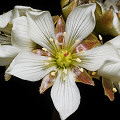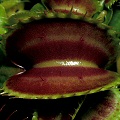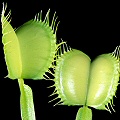Q: How did the Venus flytrap get its name?
A: Heh heh heh. Heh heh heh heh. Heh heh heh heh.

As lovely as Venus?
Here's what I tell the kids.
This is, however...what shall I call it? A "comfortable fallacy." You often see this story maintained in books about carnivorous plants, but this is because of an article that John Ellis wrote in 1768. This is what you would call a cover story:

What do you see?
The true
reason that Venus is part of this plant's name due to the dirty minds of the
kooky naturalists and nuserymen (such as John & William
Bartram, Peter Collinson, William Darlington, Arthur Dobbs, John Ellis, and Daniel Solander).
When they looked at the plant, they saw in its
amazing behavior and attractive form (two red, glistening lobes, surrounded by
hairs, sensitive to the touch), something that reminded them of female genitalia
of their own species. Indeed!
Amongst themselves, this cabal of learned perverts referred to the plant as a
"tipitiwitchet" (or "Tippity Twitchet").
It was subsequently assumed by historians that this was a
Native American term, but linguistic experts have eliminated that as a possibility.
Tipitiwitchet, it appears, was a naughty euphemism of their own devising. I like to imagine a few of them coining the term
one night as they were slamming down beers in a pub or in a sumptuous study.
I'm guessing that the originator
of the term was probably John Bartram. For while you might expect a scientist to express wonder or astonishment upon
seeing the plant, Bartram wrote to Collinson on 29 August 1762 that
"my little tipitiwitchet sensitive stimulates laughter in all ye beholders".
Surely, surely this suggests that when Bartram would show off his plant, he did so in such a
way to inspire laughter. This seems to indicate that he was showing off the plant with rude commentary!
How did modern historians disentangle this conspiracy, hundreds of years later? The truth was exposed by
a reading of a letter Peter Collinson (in England) sent to Bartram. Collinson had been hoping to see plants
since he had first heard of them from Arthur Dobbs (the Governor of North Carolina), three years
earlier in 1759. He still hoped to get seeds from Arthur Dobbs.

Governor Arthur Dobbs
But in 1762 Collinson lost hope in Dobbs. Apparently, Dobbs (73 years old) was no longer quite so interested in
things such as this plant--as remarkable as it was--because he had just gotten married to a very, very, very
young girl. On 20 June, Collinson wrote a letter to Bartram describing his frustration
with "my Friend Dobbs". This letter was the smoking gun that revealed all to subsequent
historians:
Ew! Dobb's new wife provided the old geezer with a tipitiwitchet all his own to play with. Ew!
Even worse, Dobb's new wife---young Justina Davis--was only 15! Ew!
The rude interpretation of the plant was eventually translated into Latin, which commemorates both Venus (the goddess
of Love and Sex!!), and also the plant's capturing capabilities. But it is important to observe that the specific name,
"muscipula" does not mean flytrap. That would be
"muscicapa." The Latin muscipula means mousetrap! So when
Ellis chose the Latin genus and species epithets, he chose something to recall forever the notion of the love-goddess'
grasping device that captures unwary little mammals. You nasty man!
I end with a postscript to this sordid tale of obsession with female genitalia, a contribution to the tale made by yours truly.
In my 2006 book, Growing Carnivorous Plants, I established the cultivar name for a Venus flytrap clone that had been in
circulation for many years, but which no one had ever bothered to name. It is the pure green plant, that produces no red
pigmentation at all, no matter how much light it gets. I named the plant Dionaea 'Justina Davis'
to pay honor to little Justina Davis, Dobb's wife:

Dionaea 'Justina Davis'
I boldly like to think that this minor but prurient contribution to this saga places me in good company with the crude
botanists of prior centuries.
Page citations: Nelson, E.C., and McKinley, D.L. 1990; Rice, B.A. 2006a;
personal observation.